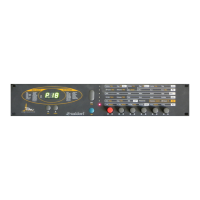User’s Manual Pulse • PulsePlus
37
8.8 VCA
The final component in the Pulse's signal chain is the VCA (voltage-controlled amplifier)
The VCA determines master volume and the stereo position. The signal is then sent to the
two outputs, where you can patch it to other devices.
An important factor in understanding how the VCA works is the fact that Envelope 2 is
always the volume modulation source. Consequently, if Envelope 2 is closed, the Pulse
cannot deliver an output signal.
The VCA is a stereo component, so you can determine the position of the signal within the
stereo panorama. You also have the option of a panaroma modulation. For this purpose,
you must define the modulation in the modulation matrix.
The parameters:
Volume 0...127 Determines the master volume of the sound program.
Velo Sens -64...+63 Determines the amount of influence key velocity has
on the volume.
Panning L64...R63 Determines the postion of the signal within the stereo
panorama. The following illustrations depict the
extreme settings. All other values lie within this range.
Far right
Center
Far left

